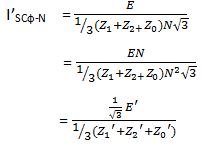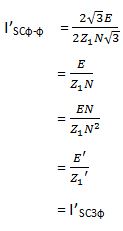Hello, it’s Steven Mill and today I want to tell you about a kinda technical subject. I’ll try to answer the following question:
“What happen in Delta-Wye transformer during phase to phase fault?”
I hope you will enjoy it! Remember that you can publish articles just like me, just send a mail to the great team.
There is some phenomenon happen when phase to phase fault occur in Delta-Wye transformer. During this fault, the overall voltage ratio is not the same as the transformer’s turn ratio. Furthermore, an unbalanced fault on one side of the transformer present differently on the other side of the transformer. In this delta wye transformer, it happen during phase – phase fault.
To give you a better understanding what make phase to phase fault different from other faults, let see what happen in the Dyn11 transformer during phase to earth fault in figure.1 below:

Figure 1. A phase to earth/neutral fault on Delta Wye Transformer
It can be seen from above figure that even though the line to line voltage ratio is , the actual turn ratio is
. When a phase to earth/ neutral fault occurs in low voltage side, the amount of the short circuit current is shown in the following formula:
The equivalent short circuit current on the HV side of the transformer is:
It is clear from the above formula that for phase to earth fault, the fault current on the LV side must be multiplied by if we want to know the referred current on the HV side.
Now, let discuss about what happen when phase-phase fault occurs in the LV side of this transformer.

Figure 2. Phase to phase fault of LV side of delta-wye transformer
The phase to phase fault is expressed in following formula:
From the figure 2 it can be seen that there is not a single referred value of the LV current on the HV side but two (as illustrate by the arrow). In other words, the HV side value is twice the LV side. Next, let use this fact to calculate the referred HV side of the LV phase to phase fault.
From the formula we know could understand that if phase to phase fault occurs in the LV side of the transformer, the HV side will see three phase fault.
It is paramount to understand this phenomena when setting a protection relay as when ISCф-ф occurs in the LV side, the LV protection will see ISCф-ф but not for HV protection. The HV protection will see I’SC3ф (the equivalent of three phase fault on LV side) and it would probably run faster than the LV protection. The HV protection could probably beat the LV protection. It is important to recognise this phenomena in advance so that the protection can be properly set up.
Other transformers with different winding connection also have a similar phenomenon and will be discussed in other article.
References:
[1] H. Reading, Protection of Distribution Network, Newcastle Upon Tyne: Newcastle University, 2014.
[2] L. Hewitson, M. Brown and R. Balakrishnan, Practical Power System Protection, Newnes, 2000.
Thanks for reading,
Steven Mill.
What’s your opinion on this article?



Great article, however I found the derivations to be very confusing. Uploading well labelled diagrams would aid in the explanation.